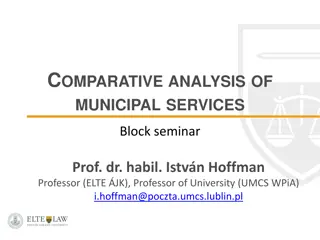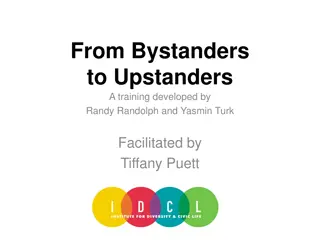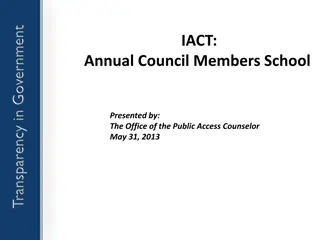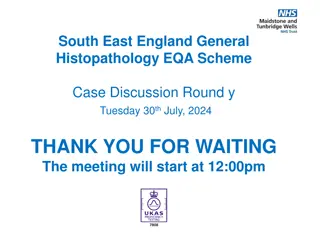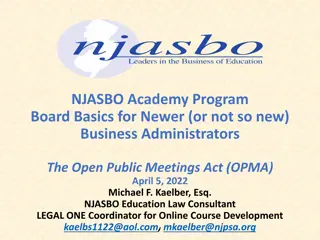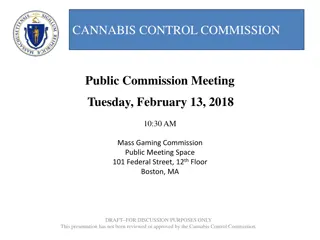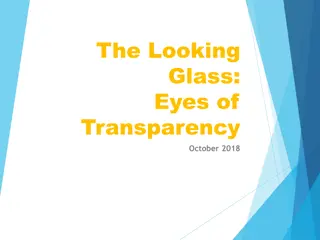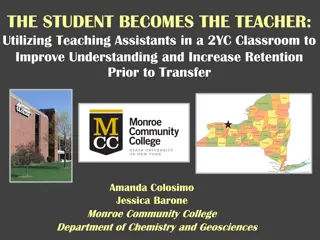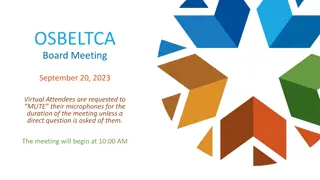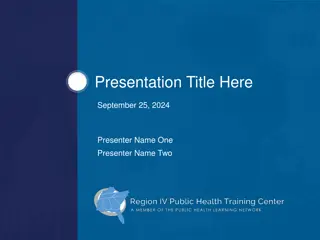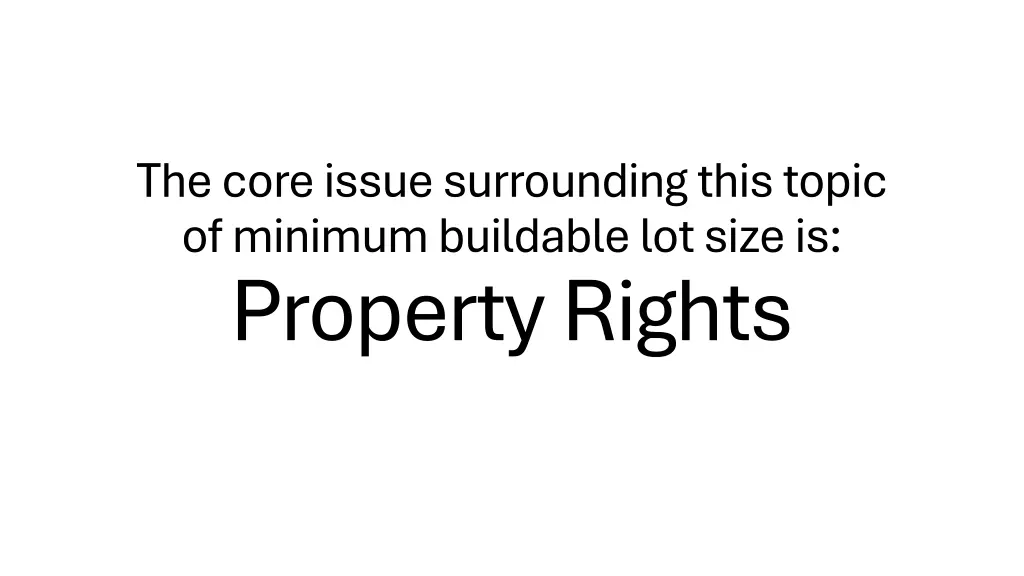
Understanding Minimum Buildable Lot Size and Property Rights
Explore the core issue surrounding minimum buildable lot sizes and property rights, delving into the concept of "use by right," the impact of zoning ordinances, and the necessity for ordinances to promote public health, safety, and general welfare. The discussion navigates the balance between city ordinances and individual property rights, proposing a reasonable minimum lot size in consideration of historical precedents in Spring City. Join the debate on the impact of lot sizes on urban characteristics and the evolution of land use regulations over time.
Download Presentation

Please find below an Image/Link to download the presentation.
The content on the website is provided AS IS for your information and personal use only. It may not be sold, licensed, or shared on other websites without obtaining consent from the author. If you encounter any issues during the download, it is possible that the publisher has removed the file from their server.
You are allowed to download the files provided on this website for personal or commercial use, subject to the condition that they are used lawfully. All files are the property of their respective owners.
The content on the website is provided AS IS for your information and personal use only. It may not be sold, licensed, or shared on other websites without obtaining consent from the author.
E N D
Presentation Transcript
The core issue surrounding this topic of minimum buildable lot size is: Property Rights
SCMC 11-1-2: Definitions states USE BY RIGHT: The right to ownership and unrestricted use of property is a basic right granted by the constitution of the United States of America. When necessary, legislative acts, laws, and ordinances are enacted to protect the health, safety, and general welfare of all concerned. If no law is in place to restrict a use or activity, such use or activity is assumed to be legal by common-law right or "use by right", except in cases where the public health, safety, or general welfare is at question.
Because zoning ordinances are in derogation of a property owner's common-law right to unrestricted use of his or her property, provision therein restricting property uses should be strictly construed and provisions permitting property use should be liberally construed in favor of the property owner.
In a nutshell this means that city ordinances should only be in place to promote Public Health, Safety and Well Being of the city and its residences; So, the land use ordinance of minimum buildable lot size should be reasonable and in favor of an individual common law property rights
So the question then is what is a reasonable minimum lot size that is only in ordinance per the definition to promote: health, safety, and general welfare,? 1.06 as the minimum lot size seams unreasonable and alienates common law property rights I believe .5 acres is a more reasonable minimum for Spring City, and history prior to 1994 illustrates this.
We can debate things like: Smaller lot size will deteriorate from the Characteristics of Spring City A. This assertion doesn t make sense as for the first 100+ years of Spring City there was no minimum lot size ordinance, people did what worked for them and was not dictated by the city. B. In 1994 when the 1.06-acre minimum ordinance was enacted there were 293 homes. 153 (or 52%) of them were built on less than1.06 acre lots. The average size of lots that were smaller than the 1.06 acre was .51acre in size. D. This naturally created a good mix of larger and smaller lots. C. Spring city became what it is with no minimum lot size ordinance, people built on the lot size that worked best for them.
We can debate if: Smaller lots could deteriorate the Agricultural character and opportunities A. agriculture was one of the original key elements of Spring City, however many many many thing have deteriorated agriculture in and around Spring City, smaller lot size had nothing to do with it, I can attest to this as I am a farmer. B. Enacting a .5-acre minimum lots size WILL NOT change anything regarding an individuals right to have larger lots for their agricultural desires, but it should be a landowner s choice of lot size, not dictated by unreasonable city ordinances. C. The 40+ current lots with large animals and the additional 40+ that could have will not be affected, people can have/keep larger lots if that s what they want and choose.
We can debate if: Reduced lot size could jeopardize the Historical District designation. A. When the historical district was applied for and achieved the majority of homes build were on smaller than the 1.06 acres, this fact alludes to smaller that 1.06 is not a deterring factor. B. The people that completed the application for the Historical District made lot size part of the application, but this was not a specific requirement of achieving the designation. C. If the number of historical sites is relevant, then the Historical District needs to be centered around the core of the town not the entire town.
D. The main street blocks from 500 N to 500 S has a mix of multiple size lots and that does not deter from the historical look or feel of Spring City. E. In these 20 blocks there are 90 lots that are less than the1.06 acres, with an average size of .48 acres, there are only 29 lots of 1.06 acre (these numbers do not include the city, church, business owned lots). F. This shows that a mix of multiple size lots actually works well and does not deter from but enhances the Spring City Character. G. This also illustrates that as the city grew from the center out smaller than1.06 was more prevalent.
We can debate things like: Strains on infrastructure A. Yes growth does require proper planning and attention to infrastructure. B. The current water and wastewater expansion projects will allow for significant growth support, including smaller lots. C. Fact is that the more connections allows for costs to be spread out which can actually help the city maintain lower utility rates while dealing with rising cost challenges. D. Roads are the biggest current challenge for the city; we are in the process of developing a Master Transportation Plan that will allow us to implement a Road Impact fee which could greatly help fund road improvements.
There is no debate regarding the cities need for additional revenue to continue to operate effectively. Will allowing smaller buildable lot size down to .5 acres solve the cities revenue shortages? Absolutely not, however; It s a fact that more connections brings significantly more income when factoring in the efficiencies of more connections per block and the additional revenue from impact fees. Our utilities department managers confirm this fact. Utility rates pay for infrastructure, not property taxes. Less connections means higher utility rates. More buildable lots directly brings more tax revenue. Future property tax rates will have to be raised more if there are less homes.
Its a fact that many people want the larger lots for the ability to have: Large animal Bigger Gardens and/or orchards Room for more out building More open space More cushion from neighbor s
Its a fact that some people want the option of smaller lots as: That s what they can afford That s what they can or are willing to maintain It allows for property equity to be achieved if larger lots can be split They can't afford for utility rates to be raised They can't afford for their property tax s to be raised Open space is not as important as affordability
In conclusion In conclusion We can debate these and other facts all night long, and both sides have what they believe to be relevant facts. So, to me the bottom line is this just boils down to what I believe the core of the issue is and that is Common Law Property Rights Common Law Property Rights Allowing people to choose choose what is best for them. .5 acre minimum is more reasonable. The city should not be forcing larger lots just because of the historical District. We should support the Historical District designation but not at the expense of alienating an individuals' property rights, both are achievable. achievable. both are Thank you, Randy Strate





